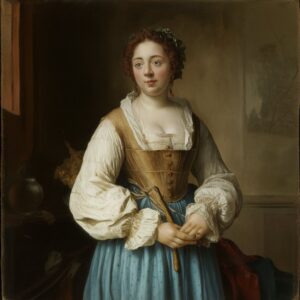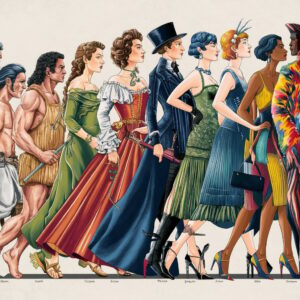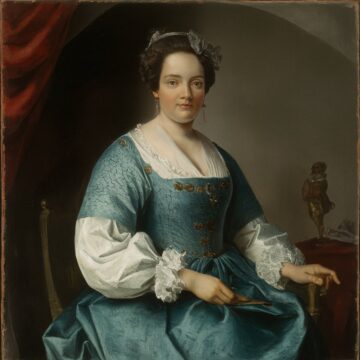How Humans First Started Wearing Clothes
Prehistoric Beginnings
The story of Clothes begins deep in our prehistoric past. Anthropologists believe that early humans first donned animal skins and vegetation as protection from harsh environmental conditions. This innovation allowed our ancestors to migrate out of Africa and adapt to new climates, marking a crucial step in human evolution.
From Simple Coverings to Complex Garments
The Neanderthals, between 200,000 and 30,000 B.C.E., were likely the first humans to create rudimentary clothing. They used their advanced cognitive abilities to craft crude tools, which helped them become skilled hunters and use animal hides for warmth. As time progressed, more sophisticated techniques emerged. Around 40,000 years ago, Cro-Magnon people developed bone needles, enabling them to sew and create more tailored garments like tunics and boots.
The Multi-Faceted Role of Early Clothing
While protection from the elements was a primary driver, Clothes quickly took on additional functions. Artifacts like ivory beads suggest that Paleolithic Clothes served cultural and social purposes, possibly signaling identity, gender, or status. As humans spread across the globe, clothing became an essential tool for survival, allowing our species to thrive in diverse environments and ultimately shaping the course of human history.
Clothing in Ancient Civilizations: Egyptians, Greeks, Romans, and More
Ancient civilizations developed diverse Clothes styles that reflected their unique cultures, climates, and social structures. From the banks of the Nile to the shores of the Mediterranean, each society crafted distinct garments that have left an indelible mark on fashion history.
Egyptian Elegance
Ancient Egyptian clothing was primarily crafted from linen, a lightweight fabric perfect for the hot climate. The upper classes adorned themselves with finer, more ornate garments, while simpler styles were worn by the common folk. Clothes served as a clear indicator of social status, with nobility sporting elaborate wigs, headdresses, and jewelry. Women often wore long, flowing dresses, while men donned loincloths or short kilts.
Greek Simplicity and Roman Grandeur
Greek fashion emphasized simplicity and functionality. The chiton, peplos, and himation were popular garments, typically made from rectangular pieces of fabric draped and secured with pins or belts. Contrary to popular belief, Greek clothing was often brightly colored, not just white.
Roman dress evolved from Greek styles but developed its own iconic elements. The toga, a symbol of Roman citizenship, was the most significant garment, worn over a tunic. Different toga styles indicated social status and occupation, becoming more voluminous over time.
Beyond the Mediterranean
Other ancient civilizations also made significant contributions to clothing history. In India, the sari, dhoti, and choli were popular, with garment length and ornamentation reflecting social hierarchy. Mesopotamian dress favored wool, featuring skirts and draped garments like cloaks and shawls. These diverse styles laid the foundation for centuries of fashion evolution.
Medieval and Renaissance Fashion: Kings, Queens, and Commoners
The Power of Clothing
In the Middle Ages and Renaissance, clothing was far more than mere fabric – it was a powerful symbol of status and identity. The quality, color, and style of one’s attire reflected their position in the social hierarchy. Nobles and royalty donned luxurious silks and velvets, while peasants wore simple wool and linen.
Opulent Nobility
The upper classes spared no expense in their wardrobes. Queen Isabeau de Bavière of France set trends that influenced all of Europe, using her lavish attire to reinforce her power. Women’s fashion centered around elaborate gowns like the houppelande, featuring high collars and wide “bombard” sleeves. Men sported doublets, hose, and their own versions of the houppelande in rich fabrics like silk velvet.
Practical Peasantry
In contrast, the lower classes dressed for function over fashion. A typical peasant outfit consisted of a loose white or cream shirt, brown pants, a dark vest, and boots. These simple garments were made to withstand the rigors of daily labor.
Fashion Extremes
The period saw some truly eccentric trends. Nobles sported extremely long-toed “Crakow” shoes, elaborate “hennin” headdresses, and exaggerated codpieces. These fashion statements pushed the boundaries of practicality, serving as clear markers of wealth and leisure.
Clothing in the Industrial Era: Mass Production and New Synthetic Fabrics
The Industrial Revolution marked a pivotal moment in the evolution of clothing, transforming both production methods and the fabrics used. This era saw the rise of mass production and the introduction of synthetic materials, forever changing the landscape of fashion and textile manufacturing.
The Rise of Mass Production
The advent of mechanized production revolutionized the clothing industry. Machines powered by waterwheels and steam engines replaced small-scale, cottage-based production, shifting the industry towards large-scale factory manufacturing. This change allowed for faster and more efficient production of textiles and garments. The invention of the sewing machine in the 19th century further streamlined clothing production, enabling mass manufacturing of standardized garments.
New Synthetic Fabrics
The 20th century witnessed the emergence of synthetic fibers, revolutionizing the textile industry. Materials like nylon, polyester, and acrylic offered advantages over natural fibers, including increased strength, elasticity, and durability. These synthetic fabrics quickly gained popularity among clothing manufacturers, often blended with natural fibers to create versatile textiles. The development of these new materials expanded the possibilities for clothing design and functionality.
Impact on Society and Fashion
Mass production democratized fashion, making trendy clothing more accessible to the general population. This shift led to the decline of small artisanal clothing makers, as factory-produced garments became more affordable and widely available. However, it also sparked concerns about working conditions and labor rights, particularly for women and children employed in textile factories.
Modern Fashion Trends: How Clothes Reflect Culture and Technology
The Digital Revolution in Fashion
In today’s interconnected world, technology has revolutionized the fashion industry, making it more accessible and diverse than ever before. E-commerce platforms and social media have democratized fashion, allowing consumers to explore and purchase styles from around the globe with just a few clicks. This digital transformation has led to a wider range of trends catering to various tastes and preferences.
Cultural Influences and Social Movements
Fashion continues to be a powerful medium for self-expression and cultural identity. Traditional garments like saris and kimonos still hold significant importance in many cultures, while also inspiring modern interpretations. Social movements have also left their mark on fashion, with styles often reflecting current societal values and concerns. For instance, the rise of sustainable and ethical fashion demonstrates a growing awareness of environmental and social issues.
The Impact of Pop Culture and Technology
Celebrities and social media influencers have become major trendsetters, capable of propelling certain styles or brands into the spotlight overnight. At the same time, technological advancements have transformed the shopping experience. Virtual try-on technologies and augmented reality allow customers to visualize clothing without physically trying it on, while artificial intelligence enables personalized recommendations based on individual preferences and past purchases.
Conclusion
As you’ve seen, the evolution of clothing has been a fascinating journey through human history. From primitive animal skins to high-tech fabrics, our attire reflects cultural shifts, technological advancements, and changing societal norms. By understanding this rich tapestry of fashion history, you gain insight into the human experience across centuries. The clothes you wear today are the result of countless innovations and cultural exchanges. As fashion continues to evolve, you play a part in shaping its future. Whether you’re a trendsetter or a classic dresser, your choices contribute to the ongoing story of clothing’s evolution. So next time you get dressed, take a moment to appreciate the incredible journey that brought that garment to your closet.

[…] conclusion, accessories play a pivotal role in modern fashion, allowing you to express your unique style and elevate any outfit. By carefully selecting and […]